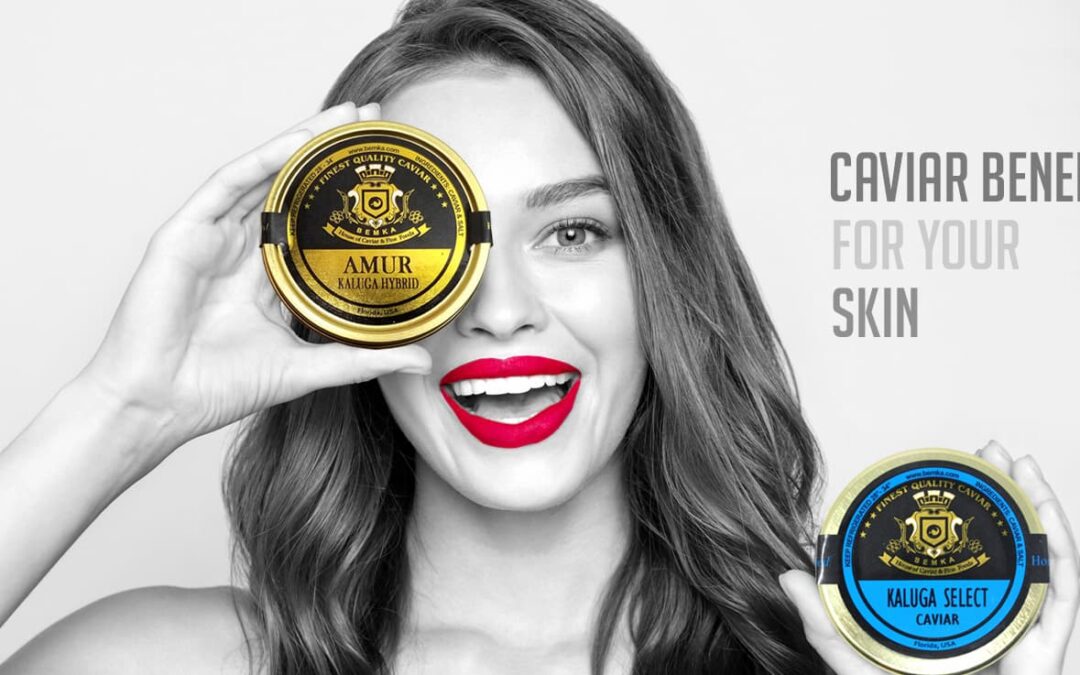
by HOCAFF Team | Apr 4, 2022 | General
Caviar is worldwide known as one of the top delicacies. Eating Caviar is a whole experience of flavors, colors, texture and elegance. Many people doubt trying Caviar because “it’s too expensive” but this is a common myth, there are more than 27 species of Caviar available for all budgets. However, this time we won’t talk about types of Caviar or how to serve it, this time you’ll know a new benefit of this ancient food.
Caviar is great for your health. It’s good for your heart, it has a lot of vitamins and minerals but did you know it can also be good for your skin? Caviar and skin care isn’t a new duo. In fact, it’s been popping up in products since the Dynasty era but it wasn’t until recently its anti-aging prowess was proved. A 2012 study showed that, when mixed with an antioxidant, Caviar could boost mitochondrial function as well as strengthen the skin’s structure. Some other independent studies have yet to conclusively prove that the proteins and minerals it contains may prevent inflammation and protect against sun damage as well.

If you’re thinking including Caviar in your skincare routine is actually putting the fish eggs in your face, you’re wrong! Caviar contains concentrated doses of omega-3 and omega-6 fatty acids that typically make it into products, but rather extracts from the nutrient-rich matrix that surrounds them.
Caviar contains so many components that make it good for your skin. Some of the one you should know are:
- Phospholipids: substances leading to deep moisturizing, skin rejuvenation and protection. They make the skin elastic, firm, with a velvety texture.
- Phosphoproteins and amino acids: substances that are essential components of collagen, elastin and NMF (Natural Moisturizing Factor). These are essential for the development and integrity of skin tissues.
- Trace elements: components essential for the smooth functioning of cells.
- Phosphorus: a high energy component and vital to skin cells.
- Metallic elements: potassium, sodium and calcium, ingredients that enhance the skin’s luminosity and feed the cells.
- O3 fatty acids for skin rejuvenation.
- Proteins: these ones offer all of those elements that make up the collagen fibers, responsible for the firmness and elasticity of the skin.

We already know Caviar has a lot of components and properties that are great for your skin, but what’s the number one benefit? Anti-aging! “Caviar extract contains antioxidant properties to protect skin against dangerous UVA and UVB rays,” explains dermatologist Michelle Henry, M.D., “This helps to prevent collagen and elastin breakdown.” It works wonders on lessening the appearance of wrinkles.
Sturgeon eggs also provide moisture and leave behind a beautiful glow, making skin appear more radiant and youthful, and its hydrating elements such as the fatty acids omega-3 and omega-6, these ones play an important role in the integrity and barrier function of the skin.
And there’s more. The extract of black caviar contains zinc that is not only immune-boosting but great for your skin. Zinc helps protect against oxidation and free-radical damage, as well as support fibroblasts, which is the building block for the extracellular matrix which forms elastin, collagen and other structural fibers which promote youthful skin. Plus, because of its immune properties, zinc is also a great skin healer.

Caviar is good for your hair, too. Caviar extract also provides great anti-aging benefits to your hair, according to experts. The UV protective and moisturizing properties that help improve the texture and quality of the skin also help the hair. Caviar extract will deliver hydration and increase the shine of hair strands so as a result you’ll get full, soft, shiny locks.
Hopefully, after all of these reasons you may be wishing to try Caviar and experience all of its benefits. House of Caviar seems like the perfect place to start with. Visit our online store and discover the greatest selection of fine food products such as:
- Caviar
- Foie Gras
- Seafood
- Meats
- Specialities
House of Caviar has everything you need! High quality products just a click away from your home. Visit us and enjoy!

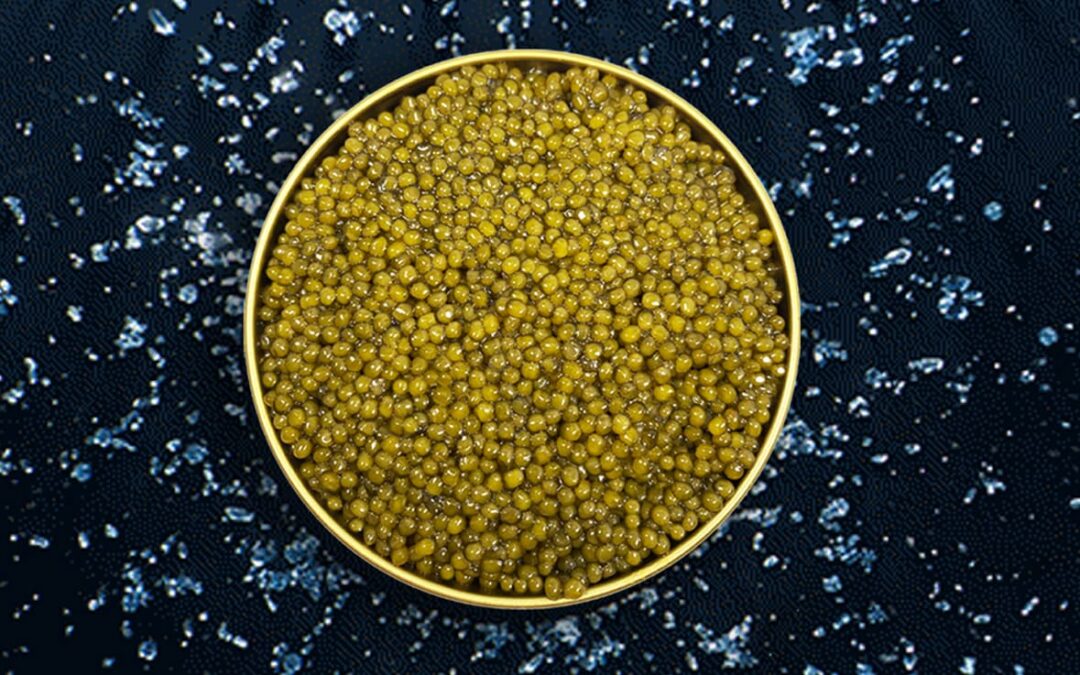
by HOCAFF Team | Mar 22, 2022 | General
Caviar is one of the top delicacies in the contemporary world. However, Caviar is not a current trend, people have been consuming it for hundreds of years. Beginning in the 1800s, fish eggs were harvested and consumed from other fish species but none have achieved the status of “true caviar”. Years later, the best quality Caviar comes from the countries around the Caspian Sea. Our caviar, Caviar farmed in regions like Italy, Romania and China producing the highest quality, and most in-demand Caviar in the world.
Back in the early days, Caviar was harvested from the wild sturgeon swimming in the Caspian and Black seas. The fisherman would capture the fish, cut out the “roe sacks” that held the eggs, and throw the fish back in to die. This overfishing critically endangered the wild sturgeons. Today, most of the world’s Caviar is being farmed across the globe, from China to the Middle East to Madagascar.
Although most of the Caviar comes from other regions different to the original ones(Domestic Caviar), Imported Caviar still being the “big deal”. Of the 27 sturgeon species, fishes like beluga, sevruga, and osetra have long dominated the Caviar world. Today you’ll learn a little bit more about them and if you’re getting excited for cooking, we’re sharing recipe ideas for each.
Beluga: is one of the most exquisite and exclusive types of Caviar. Its texture is delicate, smooth and buttery and the taste is long and complex. And when it breaks inside the mouth it is described as “magical”. However, its uncontrolled exploitation has put these types of fish at serious risk. This is the reason why Beluga Hybrid exists, a sustainable option for enjoying this type of Caviar.
Osetra: Ossetra comes in second in order of exclusivity, just behind Beluga caviar and before Sevruga. It is described as soft and loose, and the taste it leaves in the mouth can remind you of the taste of walnuts. Although Beluga is on top of exclusivity, this is definitely the most popular one among all species.
Sevruga: this may be the least expensive Caviar compared to the top three. The color of its roe is gray-black, and has the strongest flavor among Sturgeon eggs. It’s becoming a popular choice among chefs and a favorite ingredient for seafood.
Cucumber And Sevruga Caviar

Ingredients
1 cucumber
2 tablespoons Sevruga Caviar
50 grams sour cream
Start slicing the cucumber from one side like you will peel it and continue doing so till you get to the half of the cucumber. Turn the cucumber upside down and do the same thing. After you are done, start rolling the thin and long slice and pit it on a serving plate. If it doesn’t stay, use a toothpick to hold it together. With a teaspoon, put on each slice of cucumber a little sour cream and then the Caviar. You can serve it after you’re done or keep it in the fridge for 30 min.
Pappardelle with Poached Egg and Beluga Caviar

Ingredients
6 large eggs
1 Tbs. kosher salt
10 oz. good-quality dried pappardelle
4 Tbs. unsalted butter
1/3 cup freshly grated Parmigiano-Reggiano
6 tsp. Beluga Caviar
Bring a large pot of water (about 6 qt.) to a boil for the pasta. Meanwhile, fill a wide, shallow pan with water and bring to a gentle simmer. Crack each egg into a saucer and gently slide it into the simmering water. Poach the eggs until the whites are firm but the yolks are still runny, 2 to 3 minutes. Remove each egg with a slotted spoon, drain any water, and set on a warm plate. When the pasta water is boiling, add the salt and pasta. Stir frequently to keep the pasta from sticking. Use the cooking time on the package as a guide, but start checking 2 minutes sooner. When the pasta is al dente (soft but with some resistance left), drain it in a colander, reserving about 2/3 cup of the cooking water. Return the pasta to the empty pot and toss with 2 Tbs. of the cooking water, the butter, and the grated cheese. If it seems too dry, add a few more spoonfuls of water and toss again.Portion the pasta into six warm serving bowls, top each with a poached egg and the Caviar, and serve right away.
Prosciutto appetizer with truffled burrata, Osetra caviar and ligurian oil

Ingredients
8 slices Prosciutto di Parma (preferably hand carved)
2 rounds fresh burrata cheese
2 ounces Osetra Caviar
1 small piece fresh white truffle for shaving
Olive Oil for drizzling
1 teaspoon freshly cut chives
Place sliced prosciutto on plates. Quarter the burrata into wedges, place a piece on each prosciutto slice. Top with Caviar, oil, shaved truffle, and chives. Fold into a roll and enjoy.
These are only a few recipe ideas. When serving any type of Imported Caviar, the experts say it is best served on its own and cold, although there are many ways you can present it for added taste on top of its already delicious aroma. Here are a few extra options for you to try: unsalted crackers, toast, blinis, crème Fraiche, lemon wedges, minced onions or potatoes.
So, which one would you try first? Before buying Caviar make sure you go to a reputable store. Whether you’re buying online or physically, always go for fine food stores or specialized places like House of Caviar. Visit our online store and find the greatest variety of Imported Caviar and all the accompaniments you need for a perfect dish. Visit us! We’ll be looking forward to having you.

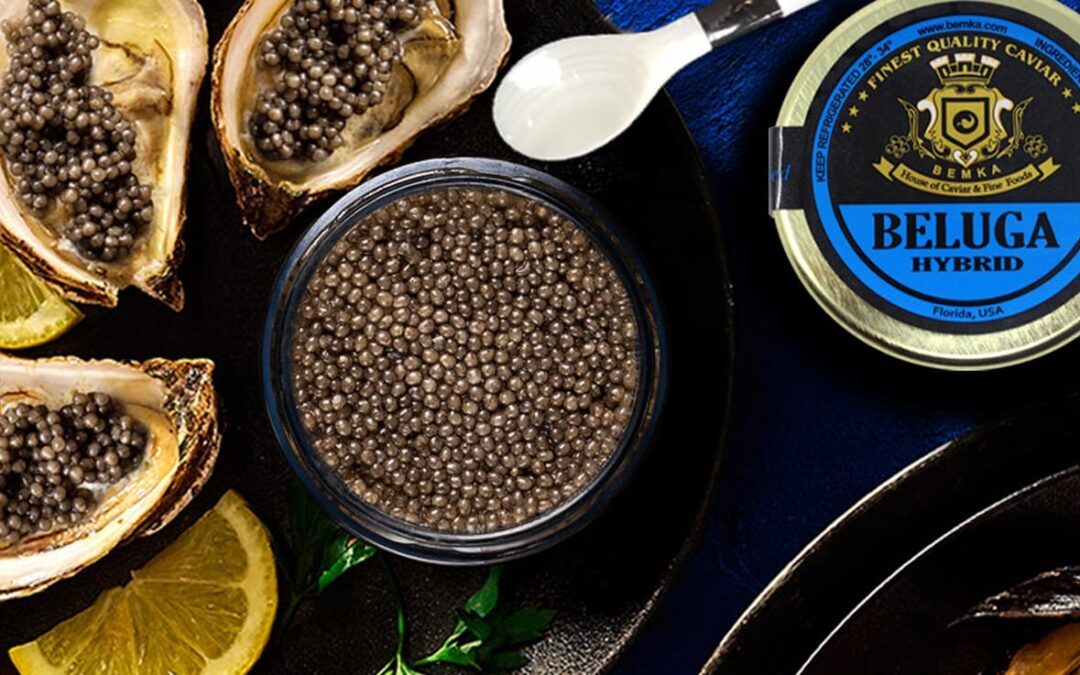
by HOCAFF Team | Feb 21, 2022 | General
When someone mentions Caviar, what comes to your mind? Is it money? Is it elegance? Is it the ocean? all of these are valid. However, Caviar has always been surrounded by myths, beliefs or misunderstandings. Caviar has a long history on this earth and many stories to tell, that’s why if you’re feeling curious about this food keep reading what’s next. House of Caviar shares with you 10 facts about Caviar that we all should know. Where does it come from? Why is it so expensive? Is it healthy? All these questions will be answered.
Let ‘s begin!
1.Where does Caviar come from?
Caviar is made from eggs of the Sturgeon fish, in some cases called ‘roe’. The majority of Sturgeon eggs come from the seas around Russia and Iran, although recently the United States and China have actually begun farming their own Sturgeon fish to produce their own Caviars. These last ones are labeled as Domestic Caviar.

2.Types of Caviar
Caviar isn’t just one. People have been consuming sturgeon Caviar for hundreds of years but did you know there are approximately 27 sturgeon especies? You’ll be able to find Caviar of all flavors, colors and budgets. Each one has its own unique qualities but the first thing you should know is there are two categories of Caviar: Imported and Domestic. Imported Caviar is the one produced in Europe originally from the Caspian Sea, and Domestic is the one harvested, produced and commercialized in the U.S.
Among all this variety, there are some types of Caviar that stand out from the rest. These are Ossetra, Beluga and Sevruga. Ossetra, is the most popular Caviar in the world, known for its rich, nutty, briny flavor and firm, juicy, deep brown to gold pearls. While still expensive, it is the most affordable high-end Caviars on the market. Beluga, is the rarest and most expensive type and is noted for its large light-gray pea-sized pearls with a buttery, creamy, nutty flavor and unique full-flavored after taste. And Sevruga, the most common and affordable from this list, has small clear pearls that have a smooth, buttery flavor with a fresh and clean finish.
3.Is all Caviar expensive?
Caviar has a big reputation as one of the most expensive delicacies in the world. Prices garnered for Caviar can be between $28,000 and $30,000 for a kilo. However, the most expensive Caviar on the market today is the extravagant “Gold laced Caviar” valued at $113,630 per kilo for these exquisitely prepared fish eggs. But not all types of Caviar are priced with thousands of dollars. Nowadays, you’ll find multiple affordable options for all budgets.
However, much of the high cost of Caviar is down to the fact that female sturgeon takes a long time to reach egg-laying maturity. For the Siberian sturgeon, the main species farmed at Exmoor, it takes between four and five years and for the white sturgeon at Agroittica Lombarda the females don’t start laying eggs until they are 14 years old. And this is just the beginning, recollecting and producing Caviar until it’s ready to commercialize is a detailed and careful process.

4.How to choose Caviar correctly?
Professionals state the very best caviar originates from wild Sturgeon, both tasting and looking much better than roe from farmed fish. This means Caviar experts say Imported Caviar types are better than Domestic ones. Nevertheless, Domestic Caviar is ending up being more popular with consumers and chefs alike and generally costs less than the wild variety.
If you want to distinguish the classy kind of Caviar, the size and color of the eggs are two facts to consider.The most expensive eggs, preferred by connoisseurs worldwide, are generally colored gold or silver and give the appearance of rare-earth elements that make them much more attractive to take a look at than delicacies made from little eggs and colored dark gray or black. However, the best Caviar is the one you like the most! Take your time to try different types and make your choice.
5.How to serve Caviar?
There are many ways to serve Caviar. The first one is to serve Caviar by itself. Just stick the Caviar tin on top of a bed of crushed ice, and serve it with a bone, mother-of-pearl, gold-plated, or even plastic spoon. It’s recommended to not use silver or stainless steel, otherwise both Caviar and spoon will suffer.
A second way to serve Caviar should be piled on blini, toast points or plain bread. Accompaniments include melted butter, minced green onions, finely chopped hard-cooked eggs, sour cream or creme fraiche, and lemon wedges.
No matter which way you’re serving it, remember to keep it simple on the portions and also, non-metallic utensils should be avoided as they can tint the natural flavor of Caviar.

6.What are the best accompaniments for Caviar?
When it comes to drinks, Champagne and vodka are the ultimate classic pairings for Caviar. But at the end it is about what you like the most , and there are plenty of other options that pair just as well. Think about the best match for your meal and that’s it.
7.Is Caviar healthy?
Caviar is not just a fancy and luxurious meal. It is also a nutritious food, packed with protein, iron, and vitamin B12. Every bite of caviar contains a large number of minerals, protein and essential fats like Omega-3 fatty acids. Caviar is also known for being a variety of natural essential amino acids such as lysine, arginine, isoleucine, methionine and histidine. Among other benefits, consuming this food also improves your skin condition, boosts the immune system and improves brain function.
8.Is Caviar a profitable business?
According to the Caviar Market Report 20022, the global Caviar market is valued at 360 million USD in 2018 and will reach 540 million USD by the end of 2025. On the other hand, journalists and Caviar connoisseurs agree that the large variety of Caviar available to buy online was a saving grace for producers since the arrival of the coronavirus pandemic and will continue being. “By selling smaller tins of caviar, both in shops and online, producers have been able to sell to consumers looking to increase everyday luxury by buying Caviar to consume at home,” says Maren Boe, analyst at Kontali.
9.What’s the future of Caviar?
Caviar is everywhere! Why? There’s a remarkable reason: the rising boom of sustainable aquaculture farms has made it a lot more approachable and affordable. Caviar produced for consumption today, is farmed under environmentally healthier conditions than their natural habitat. After being banned and prohibited due to its exaggerated production, organizations like the CITES provides general oversight of these farming operations and regulates “best practices” through a specialized coding system.

10.Where to buy Caviar?
There are a couple of tips you’d like to follow to make sure you buy Caviar at the right place. As a first option, buy at reputable brands that are primarily focused on Caviar. We recommend paying attention to the provenance, production, handling and storage of the Caviar. Stay aware of words like “imported” and “Russian”. Actually, no Caviar legally comes from Russia nowadays. If you find one of these labels, they can be put on to confuse.
A second option is to buy online and today is your lucky day! If you haven’t still found a trusted store, get your Caviar and all the fine foods you’re looking for in House of Caviar. From all types of Caviar to meats, seafood, truffles and much more, everything you’re looking for is right here! Visit our online store and discover the greatest quality products just a click away from your home.
So, did you know all of this about Caviar? If you didn’t, now you do. Caviar is a unique and exquisite food worth trying at least once in your life. Next time you’re thinking about giving it a try, come with us. We’ll be more than glad to have you!
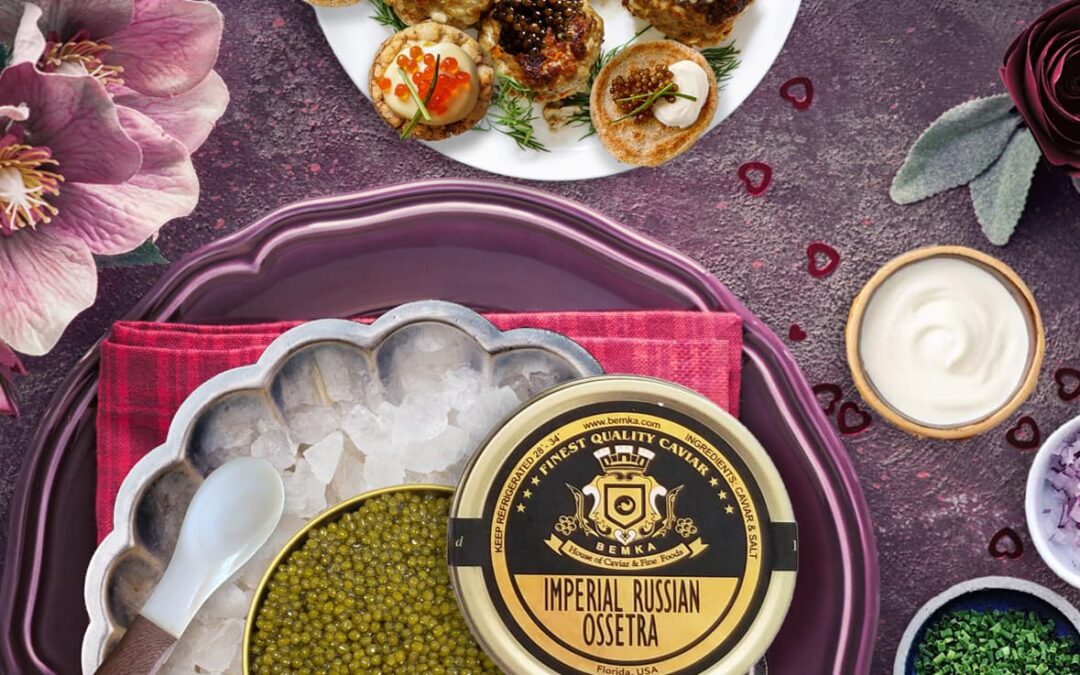
by HOCAFF Team | Feb 4, 2022 | General
Valentine’s Day is the holiday of romance. During this day lovers celebrate their affection with gifts and greetings but it also gets hard to assure dinner reservations at restaurants. So, if you’re planning to celebrate this Valentine’s Day at home, why not try something new this year? For example, Caviar.

Caviar is a synonym of elegance and tradition. Some people don’t even think about ‘cause is “too expensive”, but this is a myth. There are many types of Caviar of all flavors, textures and prices. So, for this upcoming holiday, surprise your love mate with this exquisite ingredient at your dinner table.
So, how to make the perfect dinner for Valentine’s Day? House of Caviar sharing with you gift ideas and recipes you can easily try at home. But first things first, a home-cooked dinner requires more than just cooking. You’d want to have everything you need: a setting, dishes, a drink to pair your dinner, maybe music. Here’s a list of the basics you’ll need for a perfect Valentine’s Day dinner date:
- Serve an appetizer: while you’re finishing the last details of dinner, an appetizer is the ideal entry to set the mood. Try serving an easy and quick appetizer that won’t make your mate and you get full before the main dish.
- Cook a simple dish: when cooking at home you don’t want to make it more difficult for yourself. Think about a dish that shows off your cooking skills and avoid cooking difficult to eat or messy foods.

- Drinks!: this is mandatory for your dinner. This can be an alcoholic or non-alcoholic beverage. To pair your dinner with Caviar, go for the classics: champagne or vodka.
- Use your best dinnerware: a classy dinner is nothing without the right dinnerware. Take out and clean up the best dinnerware you have at home. For Caviar, it is recommended to use a special Caviar spoon, made of bone, plastic, or mother of pearl.
Now, it’s time to get ready and start cooking. House of Caviar is sharing with you a list of gift ideas for this Valentine’s Day. These gifts include all the products you’ll need to prepare a perfect and original dinner date with Caviar.

This is the perfect basket for a full dinner for two. Includes blinis and Crème Fraiche for appetizers, two types of Caviar and the spoons to serve it!
– 2 Mother of Pearl Spoons
– 1 Mother of Pearl Server
– 1 Crème Fraiche
– 16 Blinis
– 1 Paddlefish Caviar (1oz)
– 1 Royal Siberian Caviar (1oz)

If you’re a beginner in the world of Caviar, this is the ideal basket to start with. You’ll have everything you need at a modest price.
1 – Hackleback Caviar 2 oz
1 – Paddlefish Caviar 2 oz
1 – Salmon Caviar 2 oz
1 – Blini Traditional Size 16 pc
1 – Mother of Pearl Spoon
1 – Mother of Pearl Dish
Once you have all the ingredients for your dinner date, choose a recipe that matches your needs and that’s it. If you haven’t decided yet and you’re still looking for inspiration, check cooking websites like NYT Cooking, Food & Wine, Food 52 and Yummly, there’s a lot of ideas to choose from.
With Caviar, there’s no excuse to be surprised this Valentine’s Day. Remember to always get your food at reputable stores specialized in Caviar and fine foods such as House of Caviar. Visit our online store and find more gifts, seafood, meats and of course, lots of Caviar. Come and discover all what’s waiting for you!
Enjoy our promo for Valentine’s Day.

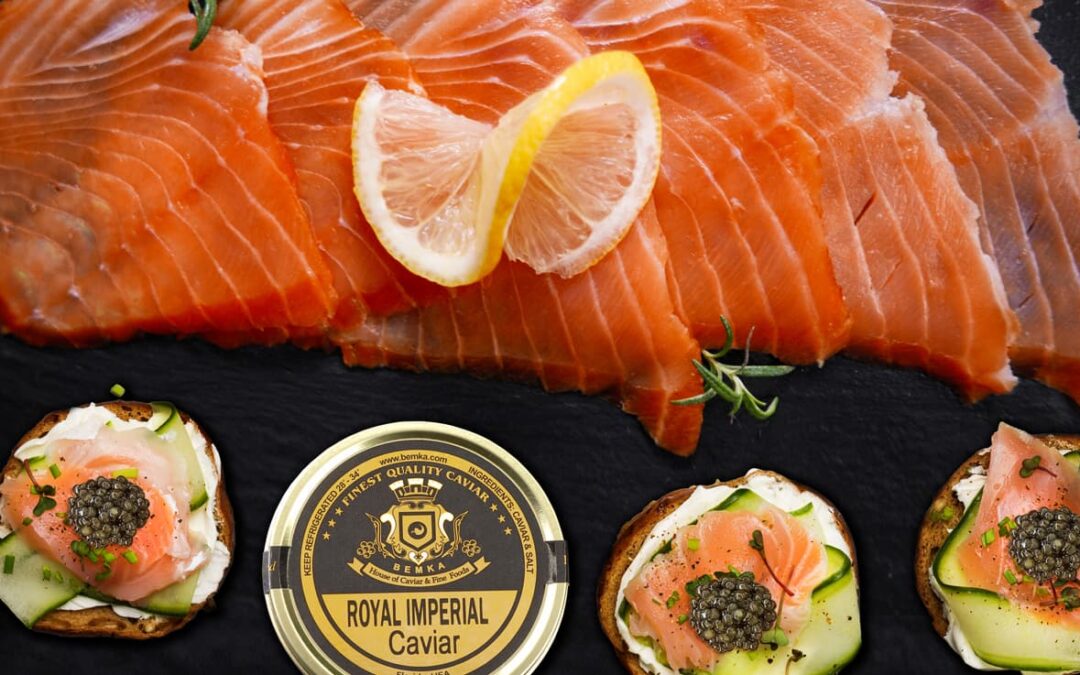
by HOCAFF Team | Jan 24, 2022 | General
Looking for a tasty, classy and affordable ingredient for your meals? The answer is Smoked Salmon. How to elevate a sandwich? Smoked Salmon. Want to prepare a different breakfast? Try Smoked Salmon with eggs. Planning a fancy dinner? Smoked Salmon and Caviar. This food is a life-saver in the kitchen and there are endless ways to serve it. But do you really know what it is? House of Caviar is telling you the basics you need to know.
The word salmon comes from the Latin salmo, which later became samoun in Middle English. Many Indigenous tribes depended heavily upon salmon in their diet during that time. In the Pacific Northwest, they used to have Smoked Salmon for two weeks so it would keep without refrigeration. It was likely tough and less palatable than fresh salmon, but it wouldn’t spoil over time.
Salmon was abundant on both the East and West coasts of America. For example, the waters of the Northwest are particularly abundant with salmon, where it is known as “Alaskan turkey.“Also, in Hawaii, it is known as Lomi Lomi, a highly prized food.

Nowadays, there are eight species of salmon in North American waters, five in Pacific waters alone. Worldwide, commercial salmon production exceeds one billion pounds annually, with about seventy percent coming from aquaculture salmon farms.
So far we already Salmon by itself; it’s a big deal. But, what do we mean when we say “Smoked Salmon”? First, it turns out that “Smoked” is a pretty generic term that could refer to any number of products. The fish itself could be farm-raised or wild-caught, and the form could be cut into filets or sliced into steaks. Second, there’s the cooking method; some Smoked Salmon is cured and cold-smoked to create a raw fish with a sushi-like texture, while others are cooked over hot smoke and turn out firm and flaky.
There are three types of Smoked Salmon you should know about: cold-smoked, hot-smoked, and salt-cured lox and gravlax (which aren’t smoked completely but it still counts). They all start out the same way: the fish is brined in a salt solution to pull out the moisture and prevent the growth of bacteria. After that, hot- and cold-smoked fish are dried and smoked, and lox takes a different path.
Although, Smoked Salmon comes in a variety of forms, the most popular is Lox. Lox, first appearing in English in 1941, comes from the Yiddish laks and originated in New York. Lox is cured in salt brine and is preferably made of Pacific salmon. This is a majorly popular menu item usually served on a bagel with cream cheese. But wait, this is the time when we get to know the recipes! House of Caviar is sharing with you three easy and classic recipes with Smoked Salmon to try at home. Pick your favorite and cook for your family dinner or friends reunion and you’ll never go wrong!
Blini with Crème Fraîche and Smoked Salmon

Ingredients
1 pack Blini
2/3 cup creme fraiche
4 ounces Smoked Salmon
1/3 cup dill sprigs
freshly ground black pepper
Caviar (Optional)
Top each blini with 1 teaspoon crème fraiche. Divide the Smoked Salmon evenly between the blini, on top of the crème fraiche. Top each with a sprig of dill and a grating of freshly ground pepper. You can also top with a tiny spoon of Caviar (Your favorite type) and serve immediately.
Poached Eggs with Parmesan and Smoked Salmon Toasts

Ingredients
Four 1/2-inch-thick slices of sourdough bread
Extra-virgin olive oil
1/4 cup freshly grated Parmesan
2 ounces thinly sliced Smoked Salmon
4 large eggs
Preheat the oven to 425°. Fill a medium skillet with water and bring to a boil. Put the bread on a baking sheet and brush all over with olive oil. Bake for about 8 minutes, or until crisp. Reserve 8 toasts. Push the remaining 8 toasts on the baking sheet close together and sprinkle the Parmesan on top in a thick layer. Bake for about 2 minutes, or until the cheese is melted. Wrap the Smoked Salmon around the remaining 8 toasts. Reduce the heat under the skillet to moderately low so the water simmers. One at a time, break the eggs into a small bowl and pour them into the simmering water. Cook until the whites are just firm and the yolks are still runny, about 3 minutes. Using a slotted spoon, transfer the eggs to paper towels and gently blot dry. Put each egg in a small, warmed bowl. Serve immediately with the Parmesan and smoked salmon toasts.
Smoked Salmon Panini

Ingredients
8 slices brioche
Dijon mustard
8 thin slices Gruyère cheese
1/2 pound thinly sliced Smoked Salmon
Finely grated zest of 1 lemon
Salt and freshly ground pepper
Heat a panini press. Spread 4 of the brioche slices with mustard and top each one with 1 slice of Gruyère; divide all of the Smoked Salmon and the lemon zest between the 4 slices. Season lightly with salt and pepper and cover with the remaining slices of Gruyère. Close the sandwiches and grill for 2 to 3 minutes, until toasted and the cheese is melted. Cut the sandwiches in half and serve.
So? Is Smoked Salmon added to your shopping list? We hope these recipe ideas have inspired you to try this food at home. And always keep in mind to get your fine food products at reputable stores like House of Caviar. Visit our website and discover all we have available for you! From Caviar and seafood to the perfect accompaniments. Come and visit us! We’ll be glad to have you around.


























